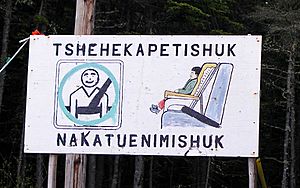Innu-aimun facts for kids
Quick facts for kids Montagnais |
||||
|---|---|---|---|---|
| Innu-aimun | ||||
| Native to | Canada | |||
| Region | Nitassinan (Quebec, Labrador) |
|||
| Ethnicity | Innu | |||
| Native speakers | 10,075, 36% of ethnic population (2016 census) | |||
| Language family | ||||
| Early forms: |
Old Montagnais
|
|||
| Linguasphere | 62-ADA-bb | |||

|
||||
|
||||
Innu-aimun or Montagnais is an Algonquian language. It is spoken by over 10,000 Innu people. These people live in Labrador and Quebec in Eastern Canada.
Innu-aimun is part of a language group that includes Cree and Naskapi. This means they are related languages. The language has different ways of being spoken, called dialects, depending on the community.
Contents
Innu-aimun in Music and Books
Since the 1980s, Innu-aimun has become more well-known. This is thanks to the rock band Kashtin. The band's founders, Claude McKenzie and Florent Vollant, later had solo careers.
They sang many hit songs in the Innu language. Some popular songs include "Ish-kuess" ("Girl") and "E Uassiuian" ("My Childhood"). Another famous song is "Akua tuta" ("Take care of yourself"). This song was even on TV shows and documentaries. Its lyrics can be found on many websites. This makes it one of the most widely available texts in a Native North American language.
Florent Vollant also sang many famous Christmas carols in Innu. He put them on his album called Nipaiamianan in 1999.
In 2013, a big dictionary was published. It included all the Innu dialects spoken in Quebec and Labrador. This dictionary is in Innu, English, and French.
How Innu-aimun Works
Innu-aimun has its own special sounds. Like all languages, it has consonants and vowels. These sounds come together to form words.
The language also has rules for how words are put together. This is called grammar. Innu-aimun is a language where words can have many parts added to them. These parts change the meaning of the word.
Words in Innu-aimun are grouped into nouns and verbs. Nouns are words for people, places, or things. Verbs are action words. Nouns can be either "animate" (like living things) or "inanimate" (like objects). They can also show if there is more than one of something.
Verbs also change based on who is doing the action. They can show when something happened, like in the past or present.
Different Ways of Speaking Innu-aimun
Innu-aimun is related to other languages like East Cree and Atikamekw. These languages are spoken by different Indigenous groups in Quebec and Ontario.
Innu-aimun itself has four main dialects:
- Southern Montagnais (spoken in Mashteuiatsh and Betsiamites)
- Eastern Montagnais (spoken in Mingan, Natashquan, La Romaine, Pakuashipi)
- Central Montagnais (spoken in Sept-Îles, Maliotenam, and Matimekosh)
- Labrador Montagnais (spoken in Sheshatshit)
Even though there are different dialects, people who speak them can usually understand each other well. The Naskapi language is also related but has some bigger differences in how it sounds and is used.
See also
 In Spanish: Innu-aimun para niños
In Spanish: Innu-aimun para niños


